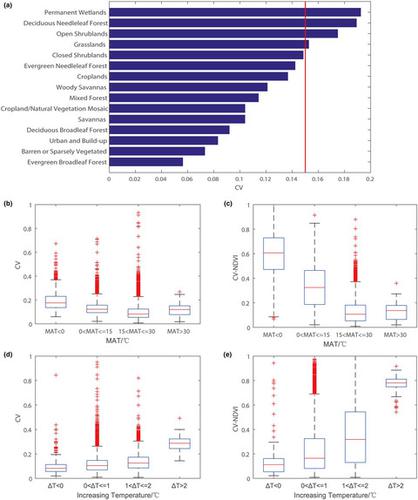当前位置:
X-MOL 学术
›
Ecol. Evol.
›
论文详情
Our official English website, www.x-mol.net, welcomes your feedback! (Note: you will need to create a separate account there.)
Modeling vegetation greenness and its climate sensitivity with deep-learning technology
Ecology and Evolution ( IF 2.6 ) Pub Date : 2021-05-02 , DOI: 10.1002/ece3.7564 Zhiting Chen 1 , Hongyan Liu 1 , Chongyang Xu 1 , Xiuchen Wu 2 , Boyi Liang 1 , Jing Cao 1 , Deliang Chen 3
Ecology and Evolution ( IF 2.6 ) Pub Date : 2021-05-02 , DOI: 10.1002/ece3.7564 Zhiting Chen 1 , Hongyan Liu 1 , Chongyang Xu 1 , Xiuchen Wu 2 , Boyi Liang 1 , Jing Cao 1 , Deliang Chen 3
Affiliation

|
Climate sensitivity of vegetation has long been explored using statistical or process-based models. However, great uncertainties still remain due to the methodologies’ deficiency in capturing the complex interactions between climate and vegetation. Here, we developed global gridded climate–vegetation models based on long short-term memory (LSTM) network, which is a powerful deep-learning algorithm for long-time series modeling, to achieve accurate vegetation monitoring and investigate the complex relationship between climate and vegetation. We selected the normalized difference vegetation index (NDVI) that represents vegetation greenness as model outputs. The climate data (monthly temperature and precipitation) were used as inputs. We trained the networks with data from 1982 to 2003, and the data from 2004 to 2015 were used to validate the models. Error analysis and sensitivity analysis were performed to assess the model errors and investigate the sensitivity of global vegetation to climate change. Results show that models based on deep learning are very effective in simulating and predicting the vegetation greenness dynamics. For models training, the root mean square error (RMSE) is <0.01. Model validation also assure the accuracy of our models. Furthermore, sensitivity analysis of models revealed a spatial pattern of global vegetation to climate, which provides us a new way to investigate the climate sensitivity of vegetation. Our study suggests that it is a good way to integrate deep-learning method to monitor the vegetation change under global change. In the future, we can explore more complex climatic and ecological systems with deep learning and coupling with certain physical process to better understand the nature.
中文翻译:

用深度学习技术模拟植被绿度及其气候敏感性
长期以来,人们一直使用统计或基于过程的模型来探索植被的气候敏感性。然而,由于这些方法在捕捉气候和植被之间复杂的相互作用方面存在不足,仍然存在很大的不确定性。在这里,我们开发了基于长短期记忆(LSTM)网络的全球网格气候 - 植被模型,这是一种强大的长期序列建模深度学习算法,以实现精确的植被监测并研究气候与气候之间的复杂关系。植被。我们选择了代表植被绿度的归一化差异植被指数 (NDVI) 作为模型输出。气候数据(每月温度和降水)被用作输入。我们使用 1982 年至 2003 年的数据训练网络,并使用 2004 年至 2015 年的数据来验证模型。进行误差分析和敏感性分析以评估模型误差并研究全球植被对气候变化的敏感性。结果表明,基于深度学习的模型在模拟和预测植被绿度动态方面非常有效。对于模型训练,均方根误差 (RMSE) < 0.01。模型验证还确保了我们模型的准确性。此外,模型敏感性分析揭示了全球植被对气候的空间格局,为我们研究植被的气候敏感性提供了新的途径。我们的研究表明,结合深度学习方法来监测全球变化下的植被变化是一种很好的方法。将来,
更新日期:2021-06-22
中文翻译:

用深度学习技术模拟植被绿度及其气候敏感性
长期以来,人们一直使用统计或基于过程的模型来探索植被的气候敏感性。然而,由于这些方法在捕捉气候和植被之间复杂的相互作用方面存在不足,仍然存在很大的不确定性。在这里,我们开发了基于长短期记忆(LSTM)网络的全球网格气候 - 植被模型,这是一种强大的长期序列建模深度学习算法,以实现精确的植被监测并研究气候与气候之间的复杂关系。植被。我们选择了代表植被绿度的归一化差异植被指数 (NDVI) 作为模型输出。气候数据(每月温度和降水)被用作输入。我们使用 1982 年至 2003 年的数据训练网络,并使用 2004 年至 2015 年的数据来验证模型。进行误差分析和敏感性分析以评估模型误差并研究全球植被对气候变化的敏感性。结果表明,基于深度学习的模型在模拟和预测植被绿度动态方面非常有效。对于模型训练,均方根误差 (RMSE) < 0.01。模型验证还确保了我们模型的准确性。此外,模型敏感性分析揭示了全球植被对气候的空间格局,为我们研究植被的气候敏感性提供了新的途径。我们的研究表明,结合深度学习方法来监测全球变化下的植被变化是一种很好的方法。将来,


























 京公网安备 11010802027423号
京公网安备 11010802027423号